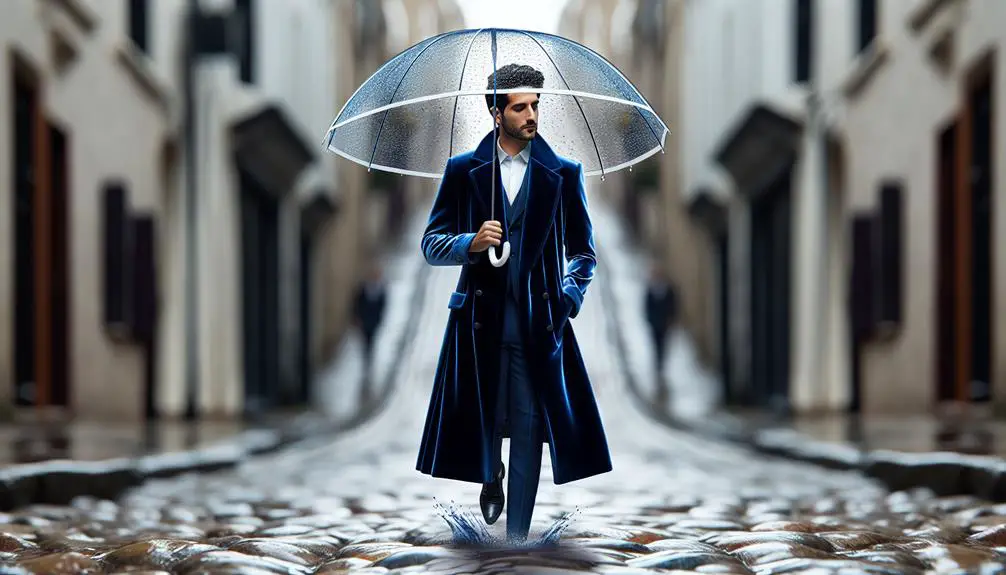I've always loved the luxurious feel of velvet, but I've often wondered about its practicality, especially when it comes to rainy weather. We all know velvet isn't the hardiest when wet, absorbing water quickly, which can lead to a host of issues like staining and loss of texture. It's tempting to save our velvet for sunny days, but are there ways to protect it and still enjoy its elegance, even under grey skies? Let's explore some possibilities and considerations that might change how we view wearing velvet in less-than-ideal weather conditions. What do you think could be a viable solution?
Table of Contents
Key Takeaways
- Velvet absorbs water quickly, potentially causing stains and loss of texture.
- Frequent rain exposure can stiffen velvet fibers and fade its color.
- Protective sprays may shield velvet from water damage.
- Consider synthetic velvet blends for better resistance to moisture.
- Waterproof accessories, like umbrellas, can help protect velvet in rainy conditions.
Understanding Velvet's Composition
Velvet's luxurious texture comes from its unique blend of natural and synthetic fibers. This elegant fabric has a rich history, tracing back to its origins in the Far East. It was highly prized among nobility in the medieval period, primarily produced from silk. Over time, production techniques evolved, allowing for broader accessibility and varied uses. Today, velvet is crafted not just from silk but also from cotton and synthetics, which enhance durability while maintaining that characteristic softness.
Understanding the production techniques of velvet is essential to appreciate its complexity. Traditionally, velvet is made using a special loom that weaves two thicknesses of the material simultaneously. These layers are then cut apart to create the pile effect that gives velvet its soft feel. Modern methods have built on these foundations, introducing more cost-effective and resilient materials, yet the essence of velvet's opulent texture remains unchanged. Each type of fiber used affects the final product's texture, appearance, and care needs, making it a versatile choice for both fashion and upholstery. This blend of tradition and innovation underscores velvet's enduring appeal and the meticulous craftsmanship behind it.
Velvet and Water: What Happens?
When velvet meets water, it's not as durable as some other fabrics.
I'll explore how velvet reacts when it gets wet and what that means for its care.
It's important to know these tips to keep your velvet looking splendid, rain or shine.
Velvet's Water Reaction
One mightn't realize that velvet reacts quite poorly to water, quickly absorbing moisture and becoming heavily stained. When we explore velvet durability, it's clear that its luscious texture belies a delicate nature, particularly with water exposure.
Traditional velvet, made from natural fibers like silk, lacks resistance to water, leading it to lose its characteristic smoothness and color depth upon getting wet. To counter this, some modern velvets undergo chemical treatments aimed at enhancing their resistance to water and stains. These treatments can help preserve the fabric's integrity and appearance, making it more resilient but still not entirely foolproof against the elements.
Understanding these aspects helps in managing expectations when using velvet in less-than-ideal conditions.
Care Tips for Velvet
To protect your velvet from water damage, it's important to follow specific care and handling tips. First off, never treat your velvet with harsh chemicals. Opt for mild detergents if you must clean it. For best velvet preservation, it's vital to avoid drenching this delicate fabric in water. Instead, use a soft brush or a dry, absorbent cloth for spot cleaning.
Additionally, while fabric softeners might seem like a good idea to keep velvet soft, they can actually leave a residue that stiffens the fabric. Stick to steaming rather than ironing to remove wrinkles without crushing the fibers. Storing velvet garments in a cool, dry place and using padded hangers also helps maintain their original luster and prevents creasing.
Immediate Care for Wet Velvet
When you get caught in the rain with your velvet attire, knowing how to handle the fabric right away can make a big difference.
Let's start by looking at the best ways to dry wet velvet without damaging it.
Next, we'll cover how to spot clean any stains before they set in.
Drying Wet Velvet
If your velvet garment gets wet, start by gently blotting the excess water with a soft towel. It's important for velvet preservation to minimize the fabric's exposure to moisture. Moisture techniques play an essential role here. Don't rub; just pat softly. After blotting, avoid the urge to wring out your velvet. This can damage the delicate fibers and alter the appearance permanently.
Next, lay the garment flat on a dry towel. Roll the towel and garment together gently, pressing lightly to absorb more moisture. Unroll and repeat with a dry towel if necessary.
Spot Cleaning Velvet
For immediate care of wet velvet, gently dab the spot with a clean, dry cloth to avoid setting the stain. When it comes to velvet, a bit of rain shouldn't spell disaster. Here's how I handle spot cleaning to make sure my velvet stays flawless:
- Blot, Don't Rub: Always blot gently. Rubbing can damage the fibers, making velvet restoration more difficult.
- Air Dry: After blotting, allow the velvet to air dry completely. This prevents any water marks from forming.
- Seek Professional Help: If the stain persists, it's wise to opt for professional cleaning. They've the right tools and expertise for delicate fabrics like velvet, ensuring your piece looks its best.
Handling velvet with care saves you from unnecessary stress and keeps your garments in excellent condition.
Long-Term Effects of Rain on Velvet
Understanding the impact of rain on velvet is crucial for maintaining its texture and color over time. The lush, plush feel of velvet can diminish with frequent exposure to water, affecting the overall look and feel of a garment. When considering velvet durability, it's important to acknowledge that while velvet exudes luxury, it isn't very forgiving when it comes to water. The fibers can become stiff and less flexible, directly impacting how the fabric drapes and moves.
Additionally, fabric discoloration is a significant concern. Velvet, particularly in darker shades, may start to appear blotchy or faded with frequent exposure to water. This isn't just about spots where rain hits hardest; the overall color depth can diminish, causing your once-vibrant garment to look dull and worn. It's a real shame, as the color richness is one of the characteristics that attracts people to velvet in the first place.
Recognizing these effects can help in understanding why velvet may not be the best choice for rainy days. It's all about preserving the unique qualities of the fabric and maintaining its luxurious appearance for as long as possible.
Protecting Velvet From Water Damage
Given the vulnerability of velvet to water damage, let's explore some effective methods to protect this delicate fabric. Whether you're stepping out for an evening event or just caught in an unexpected drizzle, keeping your velvet attire pristine needs a bit of foresight and preparation. Here are some tactics I've found invaluable:
- Use Waterproof Sprays:
Waterproof sprays can be a velvet saver. Before you head out, give your velvet garment a light spray. This creates a barrier that repels water, preventing those unsightly spots and potential fabric stiffening. Always test the spray on a small, inconspicuous area of the fabric first to make sure it doesn't alter the color or texture.
- Choose Your Moments:
Pay attention to climate considerations. If it's a light drizzle, your waterproofed velvet might withstand it. However, in a downpour, it's wise to opt for a different fabric or make sure you have adequate protective gear like a high-quality umbrella or a raincoat.
- Immediate Care Post Exposure:
If your velvet does get wet, don't panic. Gently blot (don't rub) the water out with a soft towel and hang the item in a well-ventilated area to air dry. Avoid direct heat sources like hair dryers, as they can damage the fabric.
Best Practices for Wearing Velvet
When it comes to wearing velvet, especially in damp weather, selecting the right type of velvet is essential. I've learned it's best to look for water-resistant or synthetic blends that can handle a bit of moisture.
Regular maintenance and proper storage are also key to keeping your velvet looking great, rain or shine.
Choosing Weather-Appropriate Velvet
To guarantee your velvet attire remains pristine, choose weather-appropriate options designed for durability against moisture. When looking for the right velvet to wear in damp conditions, I focus on fabrics that blend velvet durability with practicality. Seasonal velvet variations are also key to ensuring that my outfit not only looks good but withstands the weather.
Here are my top tips:
- Opt for Synthetic Blends: These velvets often handle moisture better than pure velvet, which helps maintain their luxurious texture.
- Choose Heavier Weights for Winter: Thicker velvet provides better insulation and generally fares well in colder, wetter climates.
- Consider Protective Finishes: Some velvets come with a water-resistant finish, which is ideal for rainy days.
Maintenance for Velvet Clothing
Maintaining velvet clothing requires a few simple yet essential steps to make sure it looks its best for every occasion. First off, mastering velvet folding techniques is key. Instead of hanging, fold your velvet garments along the natural creases and store them in a cool, dry place. This prevents the fabric from stretching or getting unwanted creases.
Seasonal velvet care is also vital. In the summer, I make sure to store my velvet in breathable garment bags, away from direct sunlight to avoid fading. During the winter, I use padded hangers for short-term storage to maintain the shape without crushing the pile. Always check the care label before cleaning, but generally, a professional dry clean once a season keeps velvet looking pristine.
Stylish Alternatives to Velvet in Rain
Exploring alternatives to velvet for rainy days can keep your style both chic and practical. While velvet may not fare well in wet weather, consider these three stylish and more suitable options:
- Waxed Cotton Jackets: A fantastic raincoat alternative, waxed cotton isn't only waterproof but also exudes a timeless, rugged charm. This material can handle heavy rain while maintaining an effortlessly stylish look. Brands like Barbour and Belstaff offer a variety of styles that blend functionality with fashion.
- Performance Fabrics: Modern advancements in textiles have brought us various waterproof fabrics that don't compromise on style. Look for jackets made from materials like Gore-Tex or nylon blends. These fabrics are engineered to repel water effectively while still maintaining breathability, which is essential for comfort during those damp, drizzly days.
- Water-Resistant Wool: For a more traditional approach that still offers protection against the rain, opt for water-resistant wool coats. Many designers now treat wool coats with a finish that repels water, allowing you to keep warm and dry without sacrificing the classic, sophisticated look of wool.
Choosing the right material is essential for staying dry and fashionable in the rain. Don't let a downpour dampen your style!
Velvet-Friendly Weather Accessories
When planning to wear velvet, consider pairing it with accessories that can withstand different weather conditions. Umbrella choices and raincoat styles are pivotal when stepping out in this luxurious fabric. I've found that a sturdy, oversized umbrella not only safeguards the velvet from raindrops but also adds an element of style to my overall look. Opting for a transparent or solid-colored canopy can complement the richness of the velvet, enhancing its visual appeal.
Raincoat styles are equally important. I prefer a long, water-resistant trench coat which shields the velvet effectively without compromising on elegance. The key is to choose a raincoat that's both functional and fashionable. It should provide ample coverage and feature breathable fabric to prevent any moisture buildup that could potentially harm the velvet.
Additionally, I always make sure my footwear and bag are suitable for rainy weather. Waterproof boots and a water-resistant bag guarantee that from head to toe, my outfit remains intact and stylish, even under gray skies.
How to Dry Velvet Properly
To properly dry velvet after it gets wet, start by gently blotting excess moisture with a soft towel. This first step is essential for velvet preservation because it prevents the water from seeping further into the fibers, potentially causing damage.
Here's how I guarantee my velvet items are dried correctly without compromising their luxurious texture and appearance:
- Avoid Direct Heat: Never use a hairdryer or place velvet near radiators. Excessive heat can alter the texture and even melt the fibers. Instead, let it air dry naturally in a well-ventilated area. This method ensures the fabric maintains its integrity.
- Use a Fresh Towel: Lay the velvet item flat on a clean, dry towel. Gently roll the towel and garment together to absorb more moisture. This rolling method helps in evenly distributing the pressure and therefore, preserving the fabric's original feel and look.
- No Fabric Softeners: It's tempting to use fabric softeners to keep the velvet soft, but they can actually leave a residue that affects the fabric's texture. Stick to plain water, and if you must, use a detergent specifically designed for velvet.
Velvet Maintenance and Storage Tips
Exploring your velvet garments involves careful storage to prevent creases and preserve their plush texture. I've learned that the way you fold and store velvet can greatly impact its longevity and appearance. Let's delve into some effective velvet folding techniques and tips for seasonal velvet storage that I've found invaluable.
First, always use padded hangers for hanging velvet garments to avoid hanger marks. For items that need to be folded, don't just stuff them in a drawer. Use acid-free tissue paper to line each fold, which helps prevent crushing the velvet's pile. Lay the garment flat, place the tissue paper inside, and gently fold the fabric without pressing down too hard.
When it comes to seasonal velvet storage, keep these pieces in a cool, dry place. I avoid plastic garment bags, as they can trap moisture and cause mildew. Instead, opt for a breathable fabric bag to protect your velvet from dust while allowing air circulation. It's also wise to add silica gel packets in the storage area to absorb any excess moisture.
Frequently Asked Questions
Can Velvet Shoes Be Waterproofed Effectively?
I've tried waterproofing my velvet shoes with sprays, but even after durability testing, they aren't fully waterproof. It's better for light moisture but not heavy rain or prolonged exposure to water.
Is Vintage Velvet More Susceptible to Rain Damage?
Yes, vintage velvet is more susceptible to rain damage because it's less durable. When dealing with antique care, it's important to avoid moisture to preserve the fabric's integrity and appearance.
Are There Eco-Friendly Methods to Protect Velvet?
I've found that using natural repellents and protective coatings can effectively safeguard velvet. These eco-friendly methods guarantee that my favorite garments remain pristine without compromising on environmental values.
How Does Humidity Affect Velvet Fabric Longevity?
Humidity affects velvet's longevity as moisture absorption weakens fabric resilience. I've learned it's essential to store velvet in dry conditions to maintain its luxurious texture and extend its life effectively.
Can I Iron Wet Velvet to Dry It?
I wouldn't recommend ironing wet velvet to dry it due to heat damage risks. Instead, use proper drying techniques like air-drying flat to maintain its texture and avoid any potential harm to the fabric.
- What Is Pima Cotton Percale? A Premium Bedding Option - July 14, 2025
- What Does “Percale Sheet” Mean? A Simple Definition - July 14, 2025
- Do Cotton Percale Sheets Contain Polyester? How to Read the Label - July 14, 2025







